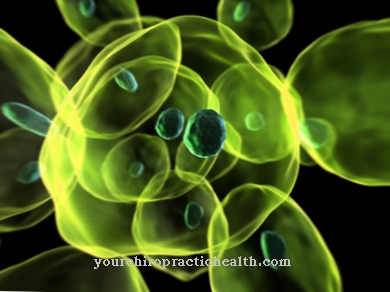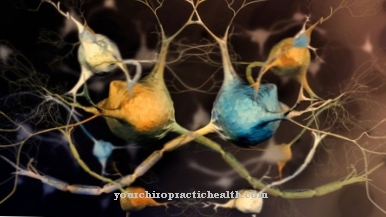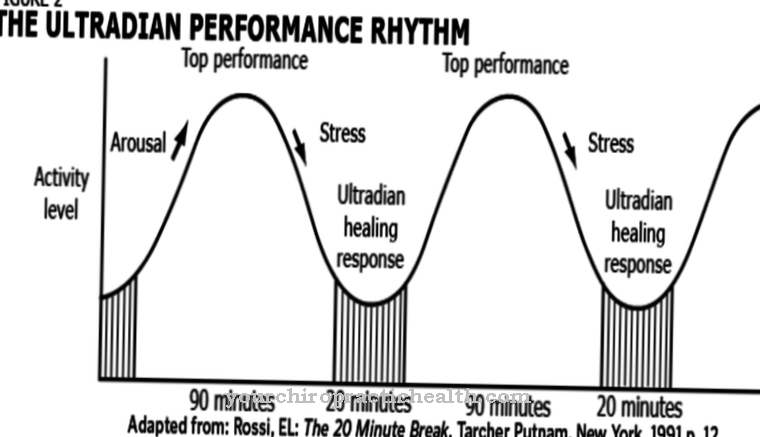Hematopoiesis is the technical word for Blood formation. It is a highly complex process that takes place largely in the bone marrow.
What is hematopoiesis?
.jpg)
Blood formation is used to supply the body with blood cells. It is important that it runs continuously and according to current needs so that there is always a sufficient number.
The different blood cells have different average lifetimes.Erythrocytes, the red blood cells, live for about 120 days, while the thrombocytes, the blood platelets, only live for about 5 to 12 days. Ultimately, billions of new blood cells are formed in the bone marrow of a healthy adult every day.
The starting point for hematopoiesis is a multipotent hematopoietic stem cell, which then undergoes cell division and differentiation steps so that it becomes more and more specialized. The term "multipotent" means that all development paths are still open to the cell in question; its further fate has not yet been determined.
The first important differentiation of the multipotent cell then takes place either into a myeloid or a lymphatic precursor cell. Now the further development is determined for her, which means that only a few variants of the development are open to her.
Function & task
So that the initial multipotent stem cell can be turned into finished blood cells, which then fulfill certain tasks for the body depending on the cell type, different approaches are now being taken. The myeloid progenitor cell has four development options. It can become an erythrocyte, a platelet, a granulocyte, or a monocyte.
The erythrocytes are the red blood cells. They are responsible for the transport of oxygen and carbon dioxide. Their formation process is called erythropoiesis. The earliest cell stage of erythropoiesis is the proerythroblast. This is a relatively large cell with a diameter of 20 µm and a centrally located core. From the proerythroblast cell divisions develop smaller and smaller erythroblasts. Their cell diameter decreases continuously while the hemoglobin content increases.
In the last developmental step still taking place in the bone marrow, the erythroblasts expel their nuclei. This turns them into reticulocytes. These can be distinguished microscopically from the finished red blood cells by the so-called substantia granulofilamentosa. Their number in the peripheral blood is proportional to the degree of erythropoiesis taking place at the time. Maturation to erythrocytes finally takes place mainly in the spleen.
Platelets are also called blood platelets. Their function is to close tissue defects. Consequently, they play an important role in wound healing and blood clotting. Thrombocytopoiesis also runs through a few intermediate stages. In detail, these are called hemocytoblast, megakaryoblast, promegakaryocyte and megakaryocyte. Finally, the thrombocytes constrict from the megakaryocytes.
Granulocytes serve the cellular immune defense. Their development takes place via the stages hemocytoblast, myeloblast, promyelocyte, myelocyte and metamyelocyte. This then gives rise to the rod-like neutrophilic granulocyte, which differentiates once more into a segmented neutrophilic granulocyte. Ultimately, the segment nuclei in the peripheral blood account for 45 to 70% of all leukocytes.
_2.jpg)
Monocytes develop through the stages of hemocytoblast, monoblast, promonocyte and monocyte. The monocytes first circulate in the blood, but then migrate into the tissue and become macrophages there. These are phagocytes that phagocytize potentially pathogenic substances and thus render them harmless.
Lymphocytes have the task of rendering infectious agents and the body's own degenerate tissue harmless. Lymphopoiesis, like other types of hematopoiesis, begins in the bone marrow. Some lymphocytes stay there until the end of their development. They are known as B lymphocytes. With other lymphocytes, the final differentiation takes place in the thymus. They are then called T lymphocytes.
Illnesses & ailments
Precisely because hematopoiesis is so important for the smooth running of numerous body functions, disorders quickly lead to sometimes life-threatening diseases. Anemia is a mild example of impaired blood formation. It is based on a disturbed erythropoiesis, which is caused in particular by a lack of substrates such as vitamin B12, iron or folic acid.
Chronic infections and rheumatic diseases can also cause the formation of erythrocytes to proceed too slowly for the current requirement. A number of other causes of anemia are also possible. Pathologically increased erythropoiesis only rarely occurs. In most cases, this is caused by tumor diseases.
If the thrombocytopoiesis does not correspond to the current need, this condition is referred to as thrombocytopenia. There is a lack of blood platelets, which can be dangerous, especially if injured. Then there is bleeding that can hardly be stopped.
Too many platelets, on the other hand, is called thrombocytosis. This is mostly due to myeloproliferative diseases in which the cell development itself is disturbed. Temporary thrombocytosis can also occur as a result of a splenectomy or large blood loss.
A leukopenia, i.e. a reduction in the number of white cells, should definitely be clarified. Since the leukocytes take on important tasks of the immune defense, even slight infections in this case can develop into life-threatening courses. Here, too, an educational disorder in the bone marrow can be the cause, but sometimes an increased consumption, as can occur in the context of an infectious disease, is the reason. Therapy depends on the cause. In severe leukopenia, antibiotics and antimycotics are administered to support the weakened body's defenses.












.jpg)



.jpg)










.jpg)
